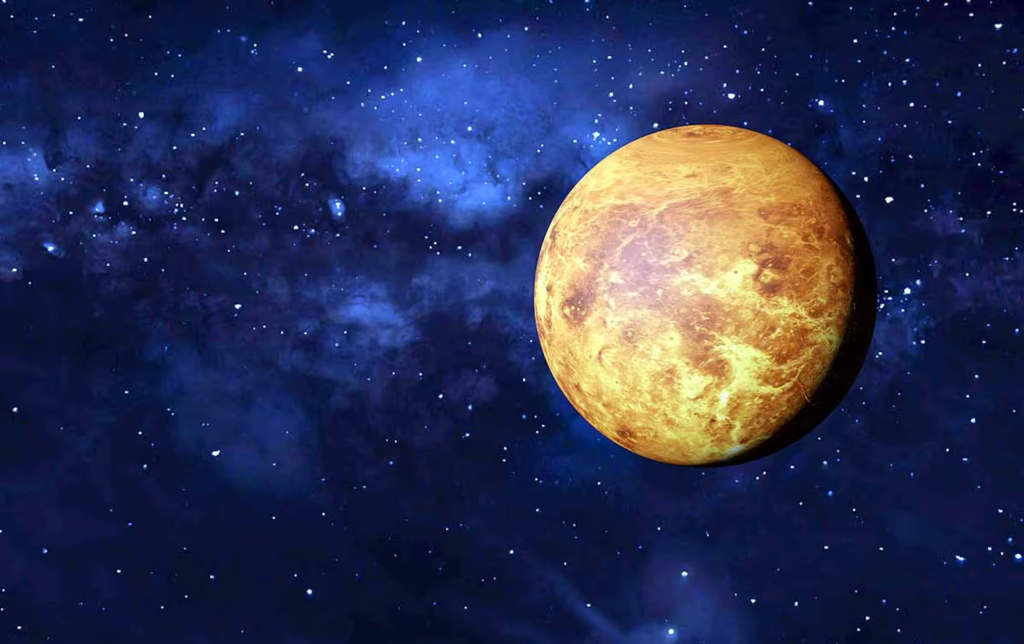1. Venus – The Dazzling Evening Star
Venus continues to light up the southwestern sky after sunset, earning its name as the “Evening Star.” This month, Venus reaches its highest position and brightest phase of the year, creating a remarkable sight for early evening viewers. A telescope reveals Venus’s crescent shape, a captivating view that resembles a tiny moon.

2. Jupiter – The Giant of the Night Sky
Jupiter remains prominent all night, positioned in the constellation Aries. It appears as a large, steady light, outshining most other objects in the sky. Through a telescope, you can view its colorful bands and four Galilean moons—Io, Europa, Ganymede, and Callisto—each dancing around the gas giant.
3. Saturn – The Ringed Beauty
Saturn is visible in the southern sky, positioned in the constellation Aquarius. Its iconic rings are best seen through a telescope, but even the planet’s steady glow is captivating to the naked eye. This month, Saturn sets just after midnight, so catch it early in the evening.
4. Mars – The Fiery Red Planet
Mars appears low on the horizon before dawn in the eastern sky, glowing with a distinct reddish hue. Though not as bright as earlier this year, Mars is still easily recognizable. For a more detailed view, a telescope will reveal its dark surface features and possibly its polar ice caps.
5. Mercury – A Morning Challenge
In late November, Mercury makes an appearance in the eastern sky just before sunrise. Look for it low on the horizon, close to where the sun will rise. Because of its proximity to the sun, Mercury is a challenging catch, but the early risers can enjoy its brief, bright presence.
6. Uranus – A Greenish Glow
Uranus is visible in the constellation Aries, close to Jupiter. While dimmer than the other planets on this list, Uranus can be spotted with the naked eye under dark skies. Through binoculars or a telescope, it appears as a tiny greenish-blue disc, a treat for those looking for a more distant planet.
7. Neptune – The Farthest Giant
Neptune, positioned in the constellation Pisces, requires a telescope to see clearly. Though faint to the naked eye, Neptune’s deep blue color is distinct through a telescope. With binoculars, you may catch its faint glow in dark sky conditions, adding an elusive outer planet to your November viewing list.
8. The Moon’s Dance with the Planets
The Moon adds extra beauty to November’s night sky, creating striking alignments with several planets throughout the month. On November 7, a thin crescent Moon will sit close to Venus, creating a stunning pair in the evening sky. Later, on November 13, the Moon will pass near Jupiter, making it easy to spot both objects together.
9. Pluto – The Distant Dwarf
Though not visible without a telescope, Pluto lies near the constellation Sagittarius this month. While faint, catching a glimpse of this distant dwarf planet is a rewarding challenge for experienced stargazers. If you’re using a high-powered telescope, seek guidance from star maps for its exact position.
10. The Leonid Meteor Shower
While not a planet, November brings the peak of the Leonid Meteor Shower, an annual event that lights up the night sky with fast-moving meteors. This year’s peak is expected around November 17, with the best views in the pre-dawn hours. For stargazers, this natural event adds excitement to an already active night sky.
Tips for November Stargazing
- Check the Weather: Clear skies are crucial for stargazing. Check your local weather forecast for cloudless nights.
- Avoid Light Pollution: For the best views, try to get away from city lights. Rural areas or parks often offer darker skies.
- Use a Star Map: Apps like SkySafari or Stellarium help you track planets and constellations, making it easier to spot these celestial highlights.
- Bring Binoculars or a Telescope: While many planets can be seen with the naked eye, binoculars or a telescope bring out more details, especially for distant planets like Uranus and Neptune.
With these tips, you’re all set for a rewarding November night sky experience. Bundle up, bring a warm drink, and enjoy the celestial wonders awaiting you this month!